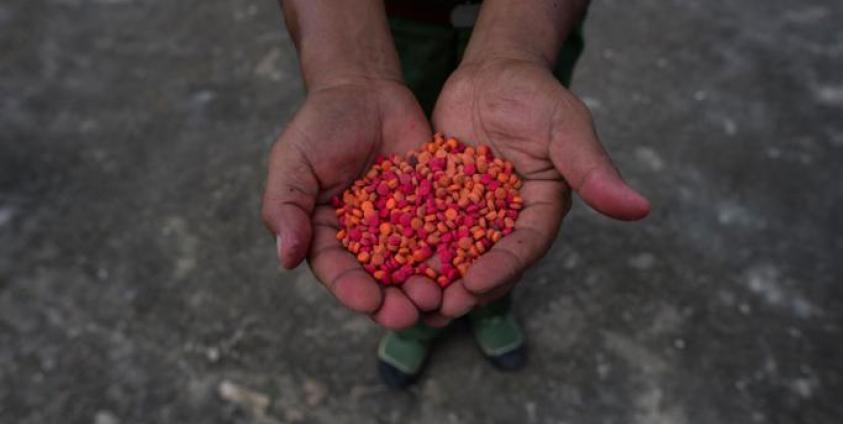(Part - 2)
As the International Crisis Group (ICG) report “Fire and Ice: Conflict and Drugs in Myanmar’s Shan State” makes clear, drugs are big business for the players in this northeastern state.
But while decades ago, the focus of drug interdiction efforts was on opium and heroin, today it is a drug that is in strong demand in Myanmar, the region, and the world.
Methamphetamines and their variations – including powerful and highly addictive Ice – make up a lucrative industry in the state.
Gram-for-gram, crystal meth is worth more than heroin, and the total value of the Mekong drug trade is estimated at over $40 billion per year and rising, according to the report.
In January 2018, the Myanmar army and police raided an abandoned house in Kutkai township in northern Shan State, seizing 30 million yaba pills, 1,750kg of crystal meth, more than 500kg of heroin and 200kg of caffeine powder. According to the authorities, it was the country’s largest-ever drug bust, with a domestic value of some $54 million. The following month, a joint army and police team raided two major crystal meth labs in the same area, seizing some seven million dollars’ worth of advanced laboratory equipment, twelve state-of-the art generators, huge quantities of precursor chemicals, and unused branded packaging sufficient for ten tonnes of product – suggesting that the labs were gearing up for a production run of that volume.
While the sizes of these seizures may have been record-setting, they were not surprising. In the last few years, authorities have regularly captured huge quantities of crystal meth in Myanmar and beyond, with the bulk thought to originate from Shan State. These included 1.2 tonnes seized in Western Australia in December 2017 and 0.9 tonnes in April that year in Melbourne; almost 5 tonnes in Thailand over the course of 2017 and 15 tonnes from January-July 2018; 1.6 tonnes in Indonesia in February 2018; and 1.2 tonnes in Malaysia in May 2018. What is clear is 2018 figures will exceed those for 2017.
The Kutkai raids were revealing in a number of ways. First, the location was not a remote, rebel-controlled part of Shan State beyond the authorities’ reach. Rather, it was relatively close to Lashio, not far from the main road to the Chinese border at Muse – Myanmar’s biggest overland trade route – in an area controlled by a militia allied with the Tatmadaw. The Tatmadaw thus had access to the area, even if law enforcement personnel did not. Crisis Group researchers could drive to the area and talk to local people there, passing through checkpoints manned by the militia and visiting the village where the abandoned house was located.
Second, authorities described both the house and the laboratories as “abandoned”. This suggests that those responsible were tipped off and fled in advance of the raids – which were triggered by Myanmar authorities being given precise coordinates of the locations and a description of the activities taking place there, so that officials apparently felt that they had no alternative but to act. There were apparently no consequences for the militia that controls the area, which has maintained a ceasefire with the military for nearly 28 years and has a large compound in Lashio town centre that Crisis Group researchers visited.
Seizures of crystal meth, as well as yaba, have increased significantly in recent years. Each massive haul tends to be presented as an interdiction victory. However, these record seizures represent the tip of an iceberg, and are therefore evidence of the scale of the problem rather than of any genuine success in addressing it. Despite massive seizures, prices of crystal meth have remained stable, a clear indication that they are a small proportion of total volumes.
The trade is becoming increasingly professionalised, dominated by transnational criminal syndicates operating at huge scale.
Yaba is produced both for local consumption and export – mainly to Thailand, Indochina and South Asia, particularly Bangladesh. Seizures in Myanmar range from a small number of tablets for personal use, to large wholesale shipments of tens of millions of pills. Crystal meth, on the other hand, is produced mostly for export – it is rarely used in Myanmar, though is starting to become more widely available. It is typically seized in one-tonne lots or larger. Key export markets for Shan State crystal meth are Japan and Australia, which have among the highest street prices in the world for the drug; a tonne has a wholesale value in Australia of at least $180 million, and street prices several times higher. Crystal meth is also exported to China, the Philippines, Malaysia, Indonesia, South Korea and New Zealand.
The trade is becoming increasingly professionalised, dominated by transnational criminal syndicates operating at huge scale. Crystal meth is now packed in branded tea packets, both to facilitate concealment and to give it a specific product identity. Increasingly, local production in destination countries is being displaced by imports: China has been effective in cracking down on illicit meth laboratories on its territory, but in practice that has meant displacing them across the border into Shan State. Australian biker gangs have opened up chapters in South East Asia as they have shifted from cooking meth in Australia using smuggled precursors, to procuring the final product in the region and smuggling that instead.
Coming up: Part 3 – Wrangling for the drug spoils








